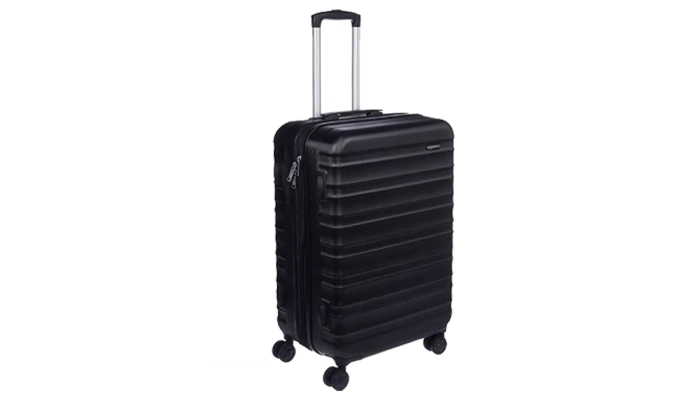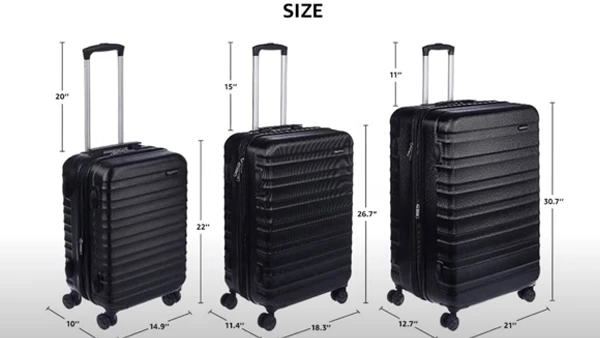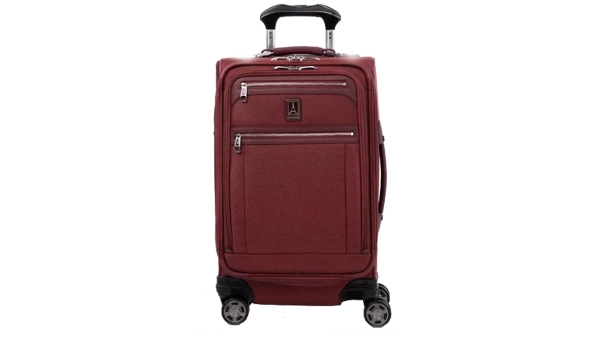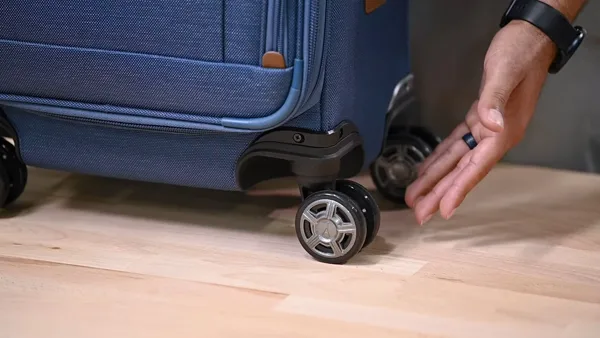
You’re packing for your vacation, and you’re trying to figure out what size of luggage to bring. It can be confusing, especially when determining whether luggage measurements include wheel dimensions. Before packing, it’s essential to know the answer to this question.
If you bring a piece of luggage that’s too small, you’ll have to pack everything tightly, and it will be hard to fit everything in. When you bring too large luggage, you will have to pay for the excess weight and lug around a heavy suitcase.
You might think that the dimensions of your luggage should include the wheels, you’re not wrong, but it’s not that simple. Let us help you find the right size for your needs, and we’ll explain how luggage measurements include wheels.
Do Luggage Measurements Include Wheels : Direct Answer

It’s essential to include wheels in your luggage measurements. Without wheels, your luggage would be shorter and wouldn’t roll as easily. By adding wheels to your measurements, you ensure that you accurately represent the total size of the luggage.
Wheels can add a few inches to the height of your luggage, so be sure to consider that when you’re measuring. You should also make sure that you measure the width and depth of your luggage, as well as the length.
These dimensions are essential when figuring out what size suitcase to bring on your trip. Many brands of luggage don’t include wheels in their product dimensions. This makes it difficult to compare different brands of luggage based on size.
Therefore, whenever you measure your luggage, always include wheels in your measurements. This is especially important if you’re trying to avoid checked baggage fees.
Reasons for Including Wheels On Luggage Measurements
Carry-on measurements include wheels and handles, a fact that most people don’t realize. This is because if the case is too long, it is not permitted as a carry-on. The same goes for width, as the wheels can make a case too wide if they’re not included in the measurement.
Here are a few reasons why it’s important to include the wheels and handles when measuring luggage:
- Get an accurate measurement: Without taking wheels and handles into account, you may end up with a case that’s too big to qualify as a carry-on and may not fit in the overhead compartment.
- It’s the measurement used by the airlines: When you’re measuring your luggage, you should use the exact measurements that the airlines use. This way, you can be sure that your bag will meet their size requirements.
- Avoid extra bag fees: If your luggage is too big to be a carry-on, you’ll likely have to pay an overweight hand baggage fee. You can avoid this fee by including measurements for wheels and handles.
- Ensure a stress-free travel experience: Nobody wants to deal with delays or extra baggage allowance at the airport. These hassles can be avoided by measuring your luggage and enjoying traveling without stress.
- Ensure that your bag fits in the overhead bin: If your carry-on is too big to fit in the overhead bin, you’ll have to check it at the gate. Including wheels and handles in your luggage measurement will help you avoid this problem.
Do the Wheels of the Luggage Affect the Overall Size Measurement?

The answer is yes, they do. This is because the wheels add to the height, width, and length of the bag. If you’re trying to fit your luggage into a space that’s just big enough, those extra few inches can make a difference.
As you decide what size suitcase you should bring on your trip, remember to measure the wheels as well. When determining whether your luggage will fit in the overhead bin or under your seat, consider the wheels’ size.
It is often overlooked by people that their luggage wheels can add to the overall size measurement. This can result in your bag being just over the size limit, resulting in a costly fee. Take into account the wheels’ size when packing your bags next time.
How is Luggage Size Measured?
Luggage size is crucial when purchasing a suitcase because it must fit overhead or under the seat in front of you on an airplane. Most people are familiar with the standard sizes for carry-on luggage – small, medium, and large.
The most common method is to measure the height of the bag from the ground to the top of the carry handle. This measurement is typically given in inches. The thing is, it’s important to note that this measurement does not include the internal dimensions of the bag – only the height of the exterior.
The overhead compartment of an airplane may not accommodate a “carry-on” bag. When choosing luggage, check your airline’s size restrictions to ensure that your bag will be allowed on board.
The following are some guidelines for carry-on luggage dimensions:
Small: 22″ x 14″ x 9″
Medium: 24″ x 16″ x 10″
Large: 27″ x 19″ x 11″
Extra Large: 30″ x 21″ x 12″
As you can see, the dimensions of the small, medium and large carry-on luggage are very similar. The main difference is in the width and depth of the bag. Since the main part of the bag is higher, a four-wheel spinner bag has less capacity than a two-wheel bag.
What is the Size of the Wheels On Standard Luggage?

The standard size for luggage wheels depends on the type of luggage. For example, the wheels on a carry-on bag are typically smaller than the wheels on a larger piece of luggage. The wheel size is also affected by the material that the luggage is made from.
Luggage wheels come in a wide range of sizes, but the most common size for standard luggage is between 40mm to 87mm. The smaller wheels are often used for lighter bags, while the larger wheels can provide more stability for heavier bags.
It is essential to note that the size of the wheels is not the only factor determining how well a bag will roll. The material used for the wheels and the spacing between them can also affect how smoothly a bag rolls.
Due to this, it is crucial to choose luggage with Wheels that are well-suited to the size and weight of the bag. Here are some general guidelines for choosing the right size wheels for your luggage:
Small wheels: 43 x 18mm
Medium wheels: 50 x 18mm
Large wheels: 76 x 24mm
Extra large wheels: 87 x 24mm
Always check the bearing size and weight capacity when selecting luggage wheels. This will ensure that your bag can roll smoothly, even when fully loaded. So, when measuring your luggage, remember to include the wheels in your measurements.
What’s the Depth of the Luggage Wheel?
When packing your luggage for a trip, you want to ensure that everything will fit comfortably and securely. One important consideration is the wheel well depth in your suitcase. Wheel well depth is measured from top to bottom of the suitcase.
Most luggage wheels are between 30mm to 50mm in depth. When choosing luggage, it is crucial to consider the wheel well depth to ensure that your bag can accommodate the size of wheels you need.
The depth of the wheel well is the distance from the bottom of the case to the top of the opening where the wheels are located. Knowing the depth of your wheel well is essential because it will determine how thick your packing material can be.
Do Airlines Count the Wheels for Luggage Measurements?

Airlines count the wheels when measuring bags for overhead storage. Despite most luggage manufacturers not including wheels in their measurements, airlines know wheels can add several inches to the bag’s length.
A few inches can make a big difference when it comes to luggage. For overhead storage, bags are typically measured by counting their wheels. Although the wheels don’t add a lot of bulk, they can still cause your bag to exceed the size limit.
The wheels increase the overall dimensions of the bag and can make it more challenging to fit into overhead storage bins or under seats. Packing for a flight requires consideration of the size of your luggage, including wheels.
If you’re planning to travel with hand luggage, it’s important to know the size restrictions that airlines often have. To be safe, it’s always best to measure your bag with the wheels included, just to be sure that it will meet the requirements.
Standard Luggage Size for Airlines, Including Wheels
If you’re planning to travel by air, it’s important to know the standard suitcase size for airlines. Your checked bag will be safely stored in the overhead bin during your flight. The typical domestic carry-on luggage size is 22″ x 14″ x 9″, including wheels and handles.
Most airlines have very specific size requirements for carry-on luggage, and if your bag is too big, it will have to be checked at the gate. This can lead to delays, lost luggage, and a general hassle. To avoid that, it’s important to know the standard domestic carry-on luggage.
Be sure to take that into account when packing. This size limit includes the handle and wheels, so be sure to take that into account when packing. If everyone adheres to this size limit, it will make for a much smoother flight for everyone involved.
What Does a 62-Bag Linear Dimension Mean for Flying?
So, what does that mean? 62 linear-inch bags are defined as any combination of length, width, and height that does not exceed 62 inches. To make it easy to remember, think of it as six feet (72 inches) plus two inches.
That means your bag can be anywhere up to 26 inches long, 16 inches wide, and four inches tall, and it will still fit within the size limits. It’s important to leave a little wiggle room – if your bag is right at the limit, there’s a chance it could be rejected at the airport.
It is better to give yourself an extra few inches of room to work with. Size restrictions on most airlines are generally not exceeded by luggage whose dimensions are 62 linear inches.
How Do You Figure Out 62 Linear Inches for Luggage With Wheels?
Linear inches is the combined total of a luggage piece’s length, width, and height. To calculate linear inches, simply add the measurements of the three dimensions. Thus, airlines use this number to determine if a bag is carry on luggage or checked luggage.
When measuring your luggage, include any handles or wheels in your calculation. You can measure your bag to get its linear dimensions in a few different ways. The simplest way is to use a tape measure. Start by laying your bag flat on the ground, then take measurements along its length.
To determine the width, measure from one side of the bag to the other. From front to back, extend the tape measure to measure the bag’s depth. Once you have these three measurements, add them to your linear dimension total.
Instead of a tape measure, you can also use a ruler to measure linear inches. Simply lay your bag flat and line up one end of the ruler with one side of the bag. Make a small mark where the other side of the bag meets the ruler.
Then, without moving the ruler, slide it down until it lines up with the bottom of the bag and make another mark. Using a tape measure or ruler, measure the distance between your two marks to determine your height.
Ensure Your Luggage Is Measured Correctly, Including the Wheels
Whether checking a bag or bringing a carry-on, it is crucial to measure your luggage accurately. This includes not only the main compartment but also any pockets or compartments with wheels.
It would be disappointing if you arrived at the airport and realized your bag was too large for the overhead compartment or that your carry-on was too heavy to carry onto the plane. Before leaving for the airport, be sure to measure your luggage.
Including handles and wheels, measure your bag from end to end to avoid any potential issues. By measuring its linear dimensions, you can determine whether the bag meets airline size requirements.
You Can Also Read:
